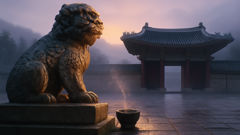Introduction
Along the ragged coasts where the Korean sea bruises itself against black basalt and high mountains slope down into foamy coves, people still tell of long bodies sliding beneath moonwater and mist. The imugi is not the dragon of carved temples and emperors; it is a serpent bound to rulelessness and possibility, a lesser-dragon whose fate is patience itself. Born of river mouths, hidden lakes, and secret springs, the imugi lives with a single, impossible appointment: survive a thousand turning years and—if fortune, ritual, and heaven allow—rise into the sky as a dragon. Villagers whisper that imugi know the taste of salt and cedar smoke, that they move like braided ink beneath the surface, and that they covet three things above all: a pearl like a captive star, the blessing of a holy master, and the patience to endure betrayal, weather, and time. This legend stretches through coastal towns and mountain hamlets, through the lantern-lit courtyards of temples and the rough-hewn boats of fishermen. In every retelling the imugi is more than monster or miracle; it is a test of human compassion and stubbornness, and of how people learn to live with the long, unhurried rhythms of myth. In this story I follow one imugi across seasons and generations, into storms and sanctuaries, watching how a creature of wet shadow inches toward a destiny that asks for a millennium of waiting.
Origins of Scale and Salt
They said the imugi were hatched where rivers meet the open sea, in the place where freshwater remembers the smell of pine and the tides remember river muddiness. In some tellings they emerged from thunderstruck stones that split and birthed living coils; in others they were the children of old dragons who never quite made the leap. On Jeju, elders insisted the imugi were made by the island winds and the patient persistence of the basalt; they swallowed the volcanic heat and learned to move like tongues of cooled lava under tides. The origin stories vary village by village, but their water—this wet world—remains the same: slow, briny, and generous with secrets. While kings carved dragons into palace gates and painted them upon silk, the imugi remained undercurrents of folk memory, present where human hands were rougher and prayers were shorter.

In the first long season, an imugi's life is a study in camouflage and appetite. It grows by swallowing fish and small whales, by slipping into eel-smeared crevices where moonlight leaves a silver trail. The scales of an imugi are not the jeweled, flamboyant armor of imperial dragons; they are moss-specked and river-dark, lacquered by years of mud and salt. Still, sometimes the world rewards a patient coil: a pebble in the shape of a moon would be polished by current until it shone like a bead, and an imugi could mistake it for the yeouiju—the dragon's pearl that legends say unlock the gate to heaven. Communities learned to read the signs of imugi presence by the sudden richness of fish catches or by the way a child's hair would stand on end when the serpent passed beneath.
Villagers spoke of bargains struck in the hush between tides. Fishermen and mothers both told stories about imugi who watched over drowned infants for a night, curling their bodies to hide the bodies from scavengers, and of other imugi who brought drought-clouds to coastal fields or ate a year's worth of nets in one greedy night. Imugi were neither entirely benevolent nor purely monstrous; their scale was the scale of the landscape itself—generous, indifferent, and inexorable. Over time, human ritual developed to address this in-between: fishermen left bowls of rice tied with red thread on the beach, monks chanted sutras at river mouths to soothe coils, and children painted tiny dragons on river stones and set them afloat so that an imugi might take them as tokens.
Even so, the heart of the imugi myth is perseverance. To become a dragon, to ascend, to be given a yeouiju or be transformed by the clearing gaze of the heavens—this required a thousand years. That number is not a neat block of time so much as a metaphoric measure of endurance. Villagers tell of imugi that lived through a dozen generations of humans, learning to read the shifts in weather and human cruelty with equal acuity. Some were patient, some cunning, and some were broken by noise and nets. The imugi's quest became a mirror for human stubbornness: to wait until one was ready, to bear the small violences of life, to hold to an inner thread of perseverance without knowing what shape it would lead to. This is why temples still leave lanterns lit by streams where imugi are believed to pass, why fishermen avoid certain wakes, and why mountain shamans are sometimes called to bless a bay after storms: the relationship between people and imugi is an uneasy contract of respect and distance, mediated by ritual, by food offerings, and by the stories elders repeat near hearths.
In the hundred-year cadence between one generation and the next, the imugi learns the world of people: the rough humor of fishermen, the solemnity of monks, the small kindnesses of children. A particular imugi—a young coil who would later be known by villagers as Seom's Thread for the way it braided through seaweed—came into being in a season of storms. Where it lived, the shoreline became a place of convergences: mountain streams poured down to meet tide pools, shells churned in sand, and the scent of pine smoke threaded the air from those who came to cut wood. Seom's Thread learned to ride currents, to slip beneath kelp forests, to avoid the netted snares that took so many of its kin. It moved like a question in the dark water, always circling forward. The villagers watched, sometimes with fear, sometimes with a quiet, indulgent fascination that comes when a story lives just outside the threshold of the home. When the moon put a coin of light on a calm night, they would look to the dark water for a silver ripple and say, 'There, the imugi remembers the sea.'
The origins of imugi remind us that myth grows from human lives that are often small and immediate. Every strand of the legend ties to a place: a mountain stream with polished pebbles, a temple's worn stone steps, a fishing boat with a child's laughter at dawn. And intertwined with these places is the slow, unglamorous work of endurance that defines the imugi: a life measured not by feats but by persistence, not by conquest but by the quiet survival of season after season.
The Trial of the Thousand Years
To speak of the imugi's thousand-year trial is to speak of modifications that are as spiritual as they are physical. Legends vary about the precise requirement: some say the imugi must obtain the yeouiju, a luminous bead of perfect shape, sometimes given by a dragon, sometimes found within the belly of the sea; others say it must undergo a rite or be acknowledged by heaven or Buddha. Whatever the mechanics, the central demand remains a test of time—one must remain intact, unseen enough to avoid being killed by nets or speared in a moment of fear, patient enough to outlive a hundred human decisions. The trial becomes a tapestry of challenges: storms that break coves into new shapes, fishermen who learn to steal the pearl before the imugi is ready, children whose curious songs draw the serpent to fresh nets, and spiritual leaders who, in the case of misaligned ritual, can anger rather than aid the imugi.

Consider Seom's Thread again, the imugi that threaded the tide pools with a certain shy intelligence. In its second century it discovered a freshwater cave hidden behind a waterfall where monks sometimes came to chant. It listened to their low, patient incantations and began to understand that human ritual could either unmake or sustain it. A priest named Hwan, who had once been a fisherman, saw the dark ripple in the pool one morning and did not cry out. Instead, he hung a simple string of prayer beads from a low pine branch and left a bowl of rice by the cave's mouth. Hwan believed that to bless the water was to honor the forms within it. In later years, people would call Hwan many things—some called him a saint, others a wise fool—but Seom's Thread knew his quiet as nourishment. It stayed near that cave long enough to taste the sweetness of long seasons where nets left it alone.
Yet the trial brings cruelties as well. There are tales of imugi whose scales were scarred by anchors, who were trapped in nets for winters and barely survived the cold. An especially dark story tells of a greedy merchant who sought the yeouiju as proof of fortune. He set a trap of copper and fire and fish-scented bait that lured a young imugi. When the trap snapped, the village rose in outrage and divided between those who would free the creature and those who feared its appetite. The merchant's greed cost him his children to the sea, the story says, and the imugi's scar turned bright white as a memory. Such tales served as moral warnings; they shaped local customs—nets with large gaps near known imugi passages, seasonal sanctuaries where boats avoided certain coves, and the keeping of offerings that might distract a curious serpent.
Beyond human malice, the imugi must wrestle with weather and time as if they were moral agents. Storms are more than storms in these stories; they are tests, doorways, and also betrayals. An imugi might ride a typhoon and be blown inland into a mountain lake where it must adapt its diet, learn the cold of snow, and listen to the silence of ice. In winter, the weight of snow on reeds can silence an imugi's breathing until it is nearly gone. In other winters, a revealing calm allows a monk to see the gleam of a pearl caught on a scale. Once, a storm lashed a fishing village so hard that boats were smashed and nets carried away. In the wreckage a young imugi found a small, round glassy stone that fishermen had mistaken for a jewel. It cradled the stone in the crook of a rocky pool for many years, believing it might be the yeouiju. Villagers whispered of a glow at the water's edge on certain nights, and a new ritual arose: to leave two bowls—one full of rice and one full of moonwater—for the imugi to choose.
The thousand years also allow the imugi to build relationships across generations. A fisherwoman named Mira left a small carved whale upon the stones outside the cave once, making the offering after her husband drowned. Mira believed that the imugi had sheltered his body until she could retrieve it. She spoke to the dark water like one speaks to memory, and the imugi learned to recognize the cadence of human grief. Different humans will help an imugi intentionally or by accident: an elderly net-mender who frees a caught coil, a child who paints small dragon eyes on a flat stone and tosses it into a stream, a Tempest-monk who chants a blessing when the water looks too troubled. Over centuries, the imugi stacks these interactions like a ledger of debts: the favors of those who see it and do not harm it, the holy words that soothe it, the small acts of care that keep it alive long enough to accumulate the thousand-year years.
Transformation itself, when it finally happens in these tales, is not a single triumphant leap but an accumulation of small acknowledgments. In one late version of the legend, an imugi does not thrust a pearl into its throat and blast off like a rocket. Instead, at the moment when the heavens decide to accept the coil, the clouds gather in a particular pattern, birds sing a chorus that has not been heard for centuries, and a monk who lies dying performs a last chant not for himself but for the creature. The imugi then feels a warmth through its scales and a loosening at its spine: it knows the thousand years have turned, and it ascends, not with a roar but with a long, slow uncoiling, leaving behind a place on the shore where the rocks are unusually smooth and where children insist flowers always grow a little brighter.
There are crueler endings too. Some imugi, despite years of care, are killed by a sudden blade or by an entire village's fear. Other times the heavens simply do not open. Yet even when the imugi fails, the legend insists its perseverance matters: the community learns humility, rites are reconsidered, and fishermen change their nets. The thousand-year trial becomes an allegory of endurance under uncertain reward. Whether an imugi becomes a dragon or not, its existence changes the human landscape: it makes people kinder in small ways, more ritualistic in others, and more aware of their vulnerability to forces far older than themselves.
The trial, when told beside hearths and under temple eaves, becomes a mirror for human effort. The imugi holds up an example of a life measured not in immediate payoff but in endurance—a lesson some human lives mirror when they keep caring for a child, a field, or a tradition beyond the time when gratitude is visible. The imugi's slow wisdom is not an easy moralizing; it is a demand that we reckon with long durations and quiet costs. It tells us that some things worth becoming require waiting without certainty, and that in the waiting we form the small, steady ties that knits a community to its own past and future.
Conclusion
In the end, the imugi's story is not solely about conquest of the sky but about what long-lived patience teaches a small world of people. In coastal and mountain villages across Korea there remain rites shaped by the imugi's presence: bowls placed on rocks, nets woven with larger knots at certain seasons, and songs children sing to keep curious hands away. The legend endures because it holds two truths at once—that there are creatures and forces beyond human reckoning and that our small acts of attention can alter the paths of those forces. The thousand-year trial becomes a mirror: a way for humans to measure their own capacity to wait, to protect, and to act with a gentleness that is sometimes the most radical sort of courage. When, on a clear night, the tide draws itself back and leaves a bright, round stone gleaming on a black rock, an elder may point and say, 'There, we once helped an imugi keep its pearl.' Whether the imugi went on to wear the crown of the dragon or sank back into the river's dark, the story keeps a small covenant between people and the living landscape—a covenant of vigilance, humility, and patient hope.













